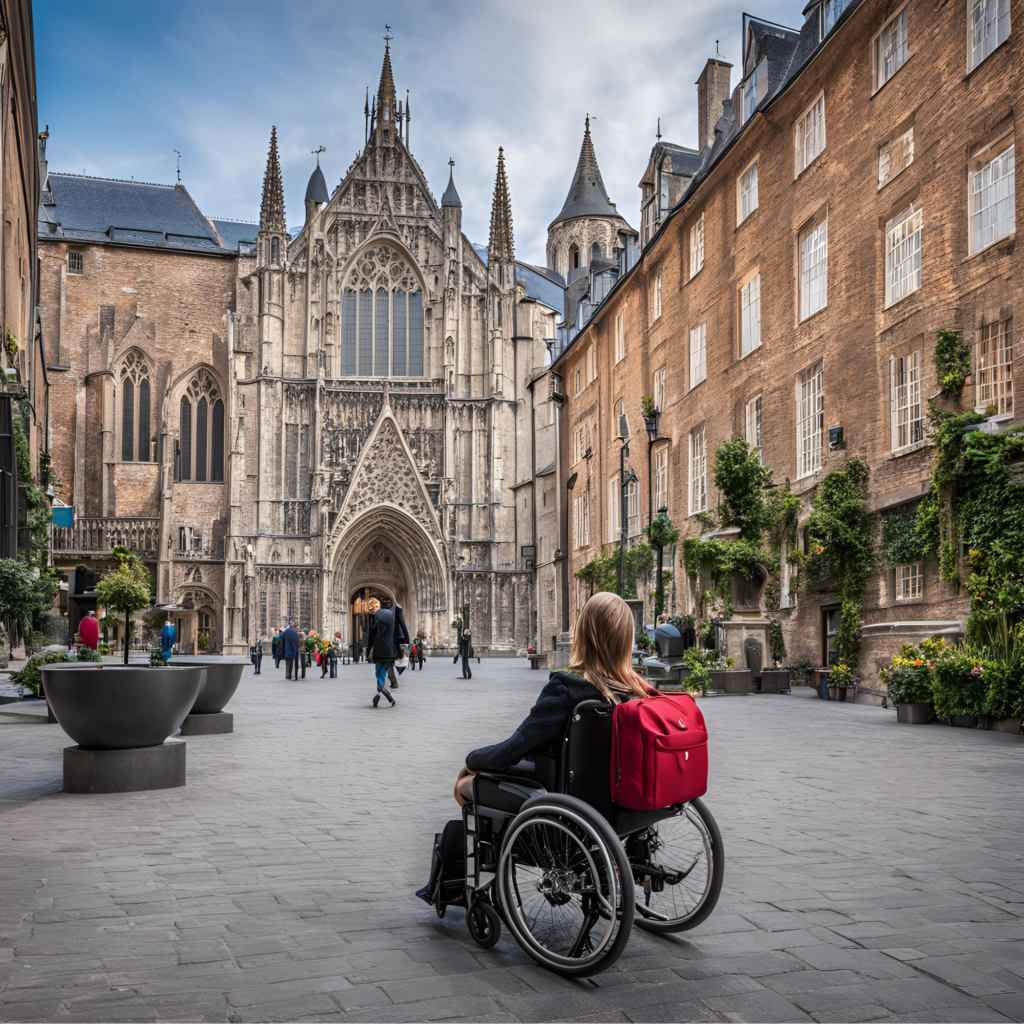Your Easy Guide to an Accessible European Holiday
Are you ready to embark on an unforgettable European adventure, but concerned about accessibility needs? We have you covered.

I know there are pockets of useful content out there, but generally speaking, I’ve found that this type of content isn’t very available. I think it’s really given me appreciation that more needs to be done, and here is my attempt at helping ever so slightly with that…
My sister has multiple accessibility requirements and is quite unique in the make-up of her needs so a lot of this has come from my personal experience as someone trying to book something for her so hopefully you find this useful!
Europe actually offers some great accessible destinations for travellers with diverse physical needs. With some planning, you can experience all the wonders Europe has to offer – and we’ve put together an easy-to-follow guide that we hope might help with that especially as someone who is helping to book travel for someone with accessibility requirements.
Why Europe is a great option for Accessible Travel
Europe has made significant progress in improving accessibility in recent years. Many cities and tourist destinations now offer a wide range of accommodations, transportation, and activities that cater to individuals with physical disabilities. Whether you’re exploring the romantic streets of Paris, hiking the scenic trails of Switzerland, or soaking up the sun on the beaches of Spain, Europe is increasingly becoming an ideal place for accessible travel.
Here’s how you can make the most of your accessible European holiday:
1. Choose the Right Accommodation: Comfort and Convenience
Many European hotels, resorts, and apartments are designed with accessibility in mind, offering features such as:
- Wheelchair ramps and wide doorways
- Roll-in showers and accessible bathroom facilities
- Elevators for multi-story buildings
To make sure you book the right place, always check the accessibility features before you commit. Don’t hesitate to reach out to the hotel directly to confirm their facilities – accessible rooms are in high demand, so booking early is essential. Countless times I’ve found what looks like a great hotel or even cruise but when I call them up, they are usually booked 🙁
Also, consider the location of your accommodation. Choose a place close to public transport, major attractions, and services that meet your needs. Some hotels even offer accessibility packages, so be sure to ask about these when booking.
2. Navigating Transportation: Getting Around with Ease
Europe has an extensive public transportation system, but accessibility can vary depending on the city or country. Here are some tips for seamless travel:
- Air Travel: Airlines are required to assist travellers with disabilities, but it’s always best to inform the airline in advance about your specific needs. You’ll often be provided with wheelchair assistance, priority boarding, and special seating but as some of you may know that this can be slow, so patience is often needed.
- Public Transport: Many European cities have made public transport more accessible, with buses, trains, trams and metro systems that accommodate wheelchairs for example. Check ahead to confirm which cities have accessible routes. Cities like Berlin, Barcelona, and Amsterdam have excellent transport infrastructure designed with accessibility in mind.
- Taxis and Private Transfers: For a more personalised experience, consider pre-booking accessible taxis or private transfers. Many cities now offer taxis with ramps and wheelchair spaces for a smoother journey.
- Car Hire: If you prefer to drive, several car rental companies in Europe offer adapted vehicles equipped with ramps or hand controls. Book these in advance to ensure availability.
3. Exploring Destinations: Discover Accessible Cities and Attractions
Cities like Amsterdam, Barcelona, and Vienna have been recognised for their accessibility and offer a mix of modern amenities, historical charm, and welcoming atmospheres.
What to Look For in Accessible Destinations:
- Attractions: Many major attractions – such as the Eiffel Tower in Paris, Colosseum in Rome, and Louvre Museum – have made significant improvements to ensure accessibility. From ramps to wheelchairs for rent, you won’t miss out on any iconic landmarks.
- Beaches: Some Mediterranean beaches, especially in Spain and Italy, provide beach wheelchairs, accessible ramps, and designated accessible areas, making it easy to enjoy the sand and surf.
- Outdoor Activities: In many countries, outdoor activities such as adaptive hiking trails, cycling paths, and sailing are designed to be accessible for all. For example, Switzerland offers accessible alpine routes with wheelchair-friendly paths.
Don’t forget to check accessibility guides for specific cities or attractions online – websites like Accessible Europe and European Disability Forum provide valuable insights.
4. Healthcare and Medical Needs: Be Prepared for Peace of Mind
Europe’s healthcare systems are generally high-quality, but having the right coverage and knowledge will give you peace of mind.
- Travel Insurance: Ensure your insurance covers medical emergencies, including assistance for your specific physical needs. This might include medical evacuation, wheelchair assistance, and coverage for medication.
- Medication: Carry enough medication for the entire trip and make sure you’re familiar with any regulations around travelling with it. Many pharmacies in Europe can fill prescriptions, but it’s best to be prepared.
- Emergency Contacts: Know the emergency number (112 in most EU countries) and have details of local hospitals and clinics in the areas you’re visiting.
5. Accessible Activities and Tours: Make the Most of Your Trip
Whether it’s a guided city tour with wheelchair-friendly transport or a museum tour with extra accommodations, there’s no shortage of exciting options!
Consider joining accessible group tours or hiring private guides who are trained in disability awareness. Many companies provide adaptive equipment like scooters and wheelchairs to make your experience even more enjoyable.
6. Accessible European Cruises: Set Sail with Comfort
Cruising is one of the most relaxing and scenic ways to experience Europe, and now, many cruise lines offer accessible options that ensure every traveller, regardless of physical needs, can enjoy the journey.
Why Choose an Accessible European Cruise?
Accessible Cabins: These cabins are spacious, with wide doors, lower beds, and adapted bathrooms with roll-in showers.
Accessible Shore Excursions: Many cruises now offer wheelchair-friendly excursions, ensuring you can enjoy ports of call and attractions without worrying about accessibility.
Onboard Support: Cruise lines assist with boarding, navigating the ship, and accessing different levels, making your experience smooth and enjoyable.
Whether you’re dreaming of a relaxing cruise along the Mediterranean or an adventurous exploration of the Baltic, KinnTravels provides personalised service and detailed information to help you choose the perfect cruise.
How to Inquire About Accessible European Cruises
You can easily get in touch with their team for advice and booking inquiries. Simply visit KinnTravels.com, where you can fill out an inquiry form or contact them directly via phone or email.
Tips for Booking Accessible European Cruises:
Book Early: Accessible cabins can be in high demand, so securing your spot well in advance is recommended.
Request Special Assistance: If you need extra help, make sure to notify the cruise line or your travel agent.
Consider the Itinerary: Choose cruises with ports of call that have accessible excursions. Some ports offer accessible transport or guided tours specifically designed for those with mobility challenges.
Plan your trip today, and get ready for a journey full of memories, new discoveries, and unforgettable experiences!
Top Tips for Booking Your Accessible European Holiday:
- Book early to secure accessible accommodations and transport.
- Check with tour operators for specialised accessible tours and activities.
- Look for destinations with excellent public transport systems.
- Ensure you have adequate medical coverage and carry any necessary medications.
- Embrace the culture – learn a few local customs and try out some local dishes to enhance your experience.
Now I am not going to try and make out I am an expert on this topic, but I hope this article did this important topic some justice. If you have any suggestions on how I can make this better, do let me know!



